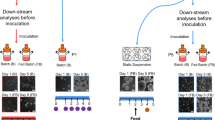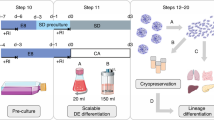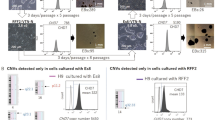Abstract
Human pluripotent (embryonic or induced) stem cells (hPSCs) have many potential applications, not only for research purposes but also for clinical and industrial uses. While culturing these cells as undifferentiated lines, an adherent cell culture based on supportive layers or matrices is most often used. However, the use of hPSCs for industrial or clinical applications requires a scalable, reproducible and controlled process. Here we present a suspension culture system for undifferentiated hPSCs, based on a serum-free medium supplemented with interleukins and basic fibroblast growth factor, suitable for the mass production of these cells. The described system supports a suspension culture of hPSC lines, in both static and dynamic cultures. Results showed that hPSCs cultured with the described dynamic method maintained all hPSC features after 20 passages, including stable karyotype and pluripotency, and increased in cell numbers by 25-fold in 10 d. Thus, the described suspension method is suitable for large-scale culture of undifferentiated hPSCs.
This is a preview of subscription content, access via your institution
Access options
Subscribe to this journal
Receive 12 print issues and online access
$259.00 per year
only $21.58 per issue
Buy this article
- Purchase on Springer Link
- Instant access to full article PDF
Prices may be subject to local taxes which are calculated during checkout


Similar content being viewed by others
References
Amit, M. et al. Clonally derived human embryonic stem cell lines maintain pluripotency and proliferative potential for prolonged periods of culture. Dev. Biol. 227, 271–278 (2000).
Amit, M. et al. Human feeder layers for human embryonic stem cells. Biol. Reprod. 68, 2150–2156 (2003).
Doetschman, T.C., Eistetter, H., Katz, M., Schmidt, W. & Kemler, R. The in vitro development of blastocyst-derived embryonic stem cell lines: formation of visceral yolk sac, blood islands and myocardium. J. Embryol. Exp. Morphol. 87, 27–45 (1985).
Itskovitz-Eldor, J. et al. Differentiation of human embryonic stem cells into embryoid bodies comprising the three embryonic germ layers. Mol. Med. 6, 88–95 (2000).
Takahashi, K. et al. Induction of pluripotent stem cells from adult human fibroblasts by defined factors. Cell 131, 861–872 (2007).
Yu, J. et al. Induced pluripotent stem cell lines derived from human somatic cells. Science 318, 1917–1920 (2007).
Amit, M. et al. Suspension culture of undifferentiated human embryonic and induced pluripotent stem cells. Stem. Cell. Rev. Rep. 6, 248–259 (2010).
Amit, M. & Itskovitz-Eldor, J. Derivation and spontaneous differentiation of human embryonic stem cells. J. Anat. 200, 225–232 (2002).
Thomson, J.A. et al. Embryonic stem cell lines derived from human blastocysts. Science 282, 1145–1147 (1998).
Park, I.H. et al. Reprogramming of human somatic cells to pluripotency with defined factors. Nature 451, 141–146 (2008).
Germanguz, Y. et al. Molecular characterization and functional properties of cardiomyocytes derived from human inducible pluripotent stem cells. J. Cell Mol. Med. 15, 38–51 (2009).
Novak, A. et al. Enhanced reprogramming and cardiac differentiation of human keratinocytes derived from plucked hair follicle, using single excisable lentivirus. Cell. Reprogram 12, 665–678 (2010).
Smith, A.G. et al. Inhibition of pluripotential embryonic stem cell differentiation by purified polypeptides. Nature 336, 688–690 (1988).
Williams, R.L. et al. Myeloid leukemia inhibitory factor maintains the developmental potential of embryonic stem cells. Nature 336, 684–687 (1988).
Conover, J.C. et al. Ciliary neurotrophic factor maintains the pluripotentiality of embryonic stem cells. Development 119, 559–565 (1993).
Rose, T.M. et al. Oncostatin M (OSM) inhibits the differentiation of pluripotent embryonic stem cells in vitro. Cytokine 6, 48–54 (1994).
Niwa, H. et al. Self-renewal of pluripotent embryonic stem cells is mediated via activation of STAT3. Genes Dev. 12, 2048–2060 (1998).
Daheron, L. et al. LIF/STAT3 signaling fails to maintain self-renewal of human embryonic stem cells. Stem Cells 22, 770–778 (2004).
Humphrey, R.K. et al. Maintenance of pluripotency in human embryonic stem cells is STAT3 independent. Stem Cells 22, 522–530 (2004).
Sato, N. et al. Maintenance of pluripotency in human and mouse embryonic stem cells through activation of Wnt signaling by a pharmacological GSK-3-specific inhibitor. Nat. Med. 10, 55–63 (2004).
Phillips, B.W. et al. Attachment and growth of human embryonic stem cells on microcarriers. J. Biotechnol. 138, 24–32 (2008).
Oh, S.K. et al. Long-term microcarrier suspension cultures of human embryonic stem cells. Stem Cell Res. 2, 219–230 (2009).
Storm, M.P., Orchard, C.B., Bone, H.K., Chaudhuri, J.B. & Welham, M.J. Three-dimensional culture systems for the expansion of pluripotent embryonic stem cells. Biotechnol. Bioeng. 107, 683–695 (2010).
Kehoe, D.E., Jing, D., Lock, L.T. & Tzanakakis, E.S. Scalable stirred-suspension bioreactor culture of human pluripotent stem cells. Tissue Eng. Part A 16, 405–421 (2010).
Chen, A.K., Chen, X., Choo, A.B., Reuveny, S. & Oh, S.K Expansion of human embryonic stem cells on cellulose microcarriers. Curr. Protoc. Stem Cell Biol. 14, 1C.11.1–1C.11.14 (2010).
Lecina, M., Ting, S., Choo, A., Reuveny, S. & Oh, S.K. Scalable platform for hESC differentiation to cardiomyocytes in suspended microcarrier cultures. Tissue Eng. Part C Methods 16, 1609–1619 (2010).
Olmer, R. et al. Long term expansion of undifferentiated human iPS and ES cells in suspension culture using a defined medium. Stem Cell Res. 5, 51–64 (2010).
Singh, H., Mok, P., Balakrishnan, T., Rahmat, S.N. & Zweigerdt, R. Up-scaling single cell-inoculated suspension culture of human embryonic stem cells. Stem Cell Res. 4, 165–179 (2010).
Steiner, D. et al. Derivation, propagation and controlled differentiation of human embryonic stem cells in suspension. Nat. Biotech. 28, 361–364 (2010).
Couture, L.A. Scalable pluripotent stem cell culture. Nat. Biotech. 28, 562–563 (2010).
Chebath, J. et al. Interleukin-6 receptor-interleukin-6 fusion proteins with enhanced interleukin-6 type pleiotropic activities. Eur. Cytokine. Netw. 8, 359–365 (1997).
Silva, G.A., Moreira, A. & Alves, J.B. Histological processing of teeth and periodontal tissues for light microscopy analysis. Methods Mol. Biol. 689, 19–36 (2011).
Acknowledgements
The authors thank M. Revel of Weizmann Institute of Science for providing the IL6IL6-receptor chimera. This research was supported by the Technion Research and Development Foundation (TRDF). J.I.-E. holds the Sylvia and Stanley Shirvan Chair in Cell and Tissue Regeneration Research at the Technion-Israel Institute of Technology.
Author information
Authors and Affiliations
Contributions
M.A. developed the concept, designed the experiments, performed data analysis and wrote the manuscript; I.L., Y.M., K.S. and M.P. provided technical assistance. J.I.-E. developed the concept, provided overall guidance, performed data analysis and interpretation, revised and provided final approval of the manuscript.
Corresponding author
Ethics declarations
Competing interests
The authors declare no competing financial interests.
Rights and permissions
About this article
Cite this article
Amit, M., Laevsky, I., Miropolsky, Y. et al. Dynamic suspension culture for scalable expansion of undifferentiated human pluripotent stem cells. Nat Protoc 6, 572–579 (2011). https://doi.org/10.1038/nprot.2011.325
Published:
Issue Date:
DOI: https://doi.org/10.1038/nprot.2011.325
This article is cited by
-
Efficient generation of hPSC-derived midbrain dopaminergic neurons in a fully defined, scalable, 3D biomaterial platform
Scientific Reports (2017)
-
Cell fiber-based three-dimensional culture system for highly efficient expansion of human induced pluripotent stem cells
Scientific Reports (2017)
-
Induced pluripotent stem cells: at the heart of cardiovascular precision medicine
Nature Reviews Cardiology (2016)
-
Bulk cell density and Wnt/TGFbeta signalling regulate mesendodermal patterning of human pluripotent stem cells
Nature Communications (2016)
-
Human pluripotent stem cell process parameter optimization in a small scale suspension bioreactor
BMC Proceedings (2015)
Comments
By submitting a comment you agree to abide by our Terms and Community Guidelines. If you find something abusive or that does not comply with our terms or guidelines please flag it as inappropriate.



